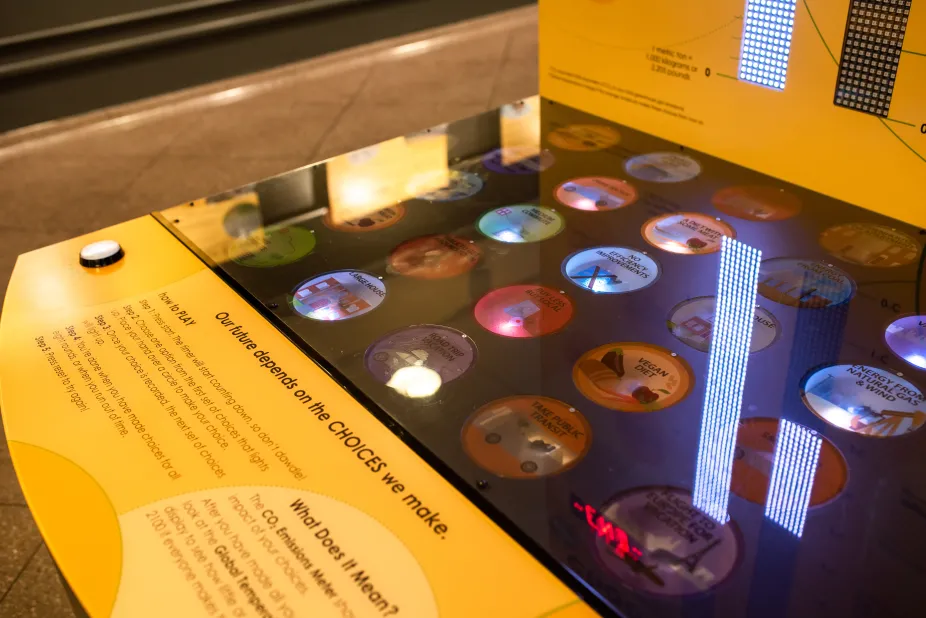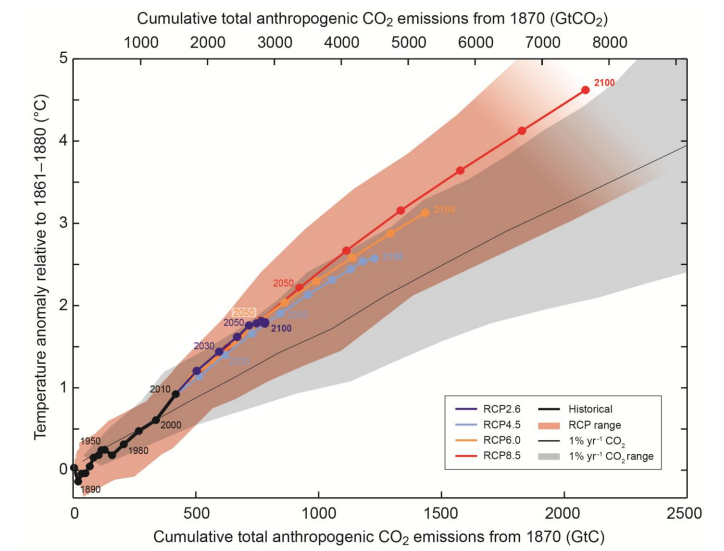Our Future

Choose Our Future Exhibit at the Mesa Lab
UCAR
Choose our future
Every day, you make hundreds of choices which can impact climate change by changing the amount of greenhouse gases you emit, either directly (e.g. by burning fossil fuels in your house or car), or indirectly (e.g. having things made for you, or transported around for you).
In the Choose Our Future exhibit at NCAR, you can see how those choices add up to make your carbon footprint, and what the effect would be on the climate if everybody acted the same way as you in the future.
How does the exhibit work?
Calculating your footprint
When you play the game, you have to answer a few questions about your lifestyle. Each of these choices represents one aspect of your life, which when combined together total up to make your carbon footprint. There are 5 categories: housing, food, local transportation, vacation travel, and consumption. You can make changes to each of these to change your total footprint:
Housing
The first category concerns emissions which are related to how you heat your house, and how you get your electricity. The game asks you a few questions, which tell you how your household emissions add up.
- Energy Source - where you get your electricity from changes the carbon footprint of your house. The average electricity from the US national grid puts 6.9 tons of carbon dioxide (CO2) into the atmosphere for every kWh of electricity you consume. If you sign on to a 'green' plan, this number comes down to 5.2 tons, and if you get all your electricity from your own solar panels, you can bring the number down to 0.5 tons.
- House size - the bigger your house is, the more energy is required to heat and illuminate it, so if you live in a larger than average house, these numbers go up (and if you live in an apartment, they go down!). The average US person has 830 square feet of space per person, while the average person in Hong Kong has only 161 square feet per person.
- Energy efficiency - by making your house more efficient (adding insulation, adding LED lighting and installing low power appliances), you can reduce its footprint by about 20 percent (or more, depending on your particular situation).
Local Transportation
How you get around can make big differences to your yearly greenhouse gas emissions. If you drive a large car or truck to school or work, you are emitting 350g of CO2 for every mile you drive. This means if you drive 18 miles (the US average) every day, your commute emits 1.6 tons of CO2 into the atmosphere each year. But you can reduce this number in a couple of ways:
- Live closer to work - the shorter your commute is, the less you have to emit!
- Use a lower emission form of transport- if you drive an efficient car like an electric vehicle, you can reduce your emissions (but be aware of where your electricity comes from - an EV can produce more CO2 than some hybrids in states which use lots of coal). You can lower your commuting emissions even more by using public transport, biking, or walking to work!
Vacation Travel
Flying is the most carbon intensive activity you are ever likely to do. A single flight from Denver to London puts 2 tons of CO2 into the atmosphere. That's more than most cars produce in a year. By reducing the number of times you fly per year, you can dramatically shrink your carbon footprint.
Food
What you eat has a surprisingly large effect on your annual emissions, and by far the biggest change you can make is to reduce your red meat consumption. A person who eats a large amount of red meat can produce nearly 4 tons of CO2 equivalent every year, whereas a strict vegan only accounts for 0.7 tons of CO2 per year. This is because cows, sheep, and other grazing animals produce methane, which is a highly potent greenhouse gas.
Your consumption
Calculating the world's footprint
Once we've worked out what your carbon footprint is, the game uses it to calculate a future emissions pathway for the world, assuming that the average American behaves like you do in the future. To make our projection, we use the Shared Socioeconomic Pathways, which are a set of possible futures which scientists have put together so they can run climate simulations with different assumptions about how society will change in the coming century.
The future we use is called SSP5, and it assumes that the world is going to get richer in the future and that technology will continue to improve. In this future, if humanity decides to do nothing about climate change, greenhouse gases will continue to increase and the temperatures at the end of the century will be over 4 degrees Celsius (C) warmer than today. However, if society decides to act on climate change quickly, that number can be reduced to 2 degrees C. The scientists make 5 different versions of SSP5, assuming that humanity makes a lot of effort to stop climate change, no effort at all, or something in between.
This is useful because it lets us see what the average American emissions would be in 2040 in each of the 5 futures.

On the x-axis of the above figure is the US emissions in 2040 in each of the 5 versions of SSP5. So, in the future where society makes no effort to stop climate change, the average US emissions in 2040 is 20 tons per person. This is just a little higher than the average US person's emissions today, which is 17 tons. But in a future where humankind makes a lot of effort, the average US person would emit only 10 tons in 2040. So when you complete the game, we make the assumption that the average American is behaving like your answers in 2040, and then we use that information to work out what path we're on.
On the y-axis of the plot is the cumulative CO2 emissions from all of humanity, from the industrial revolution until 2100, in each of the versions of SSP5. Right now, humanity has emitted over 600 billion tons of carbon. If humanity makes no effort to stop climate change, and we follow the highest version of SSP5, then we will emit 2.5 trillion tons by the year 2100. But if we take immediate action and follow the lowest emission version of SSP5, cumulative emissions could be held underneath 1 trillion tons.
Once we know from your answers what pathway we're on, we can make a prediction of what cumulative emissions will be in 2100.
Producing a temperature prediction
Once we know the cumulative emissions of carbon which humanity will produce by 2100, we can produce a temperature forecast by looking at this plot, which shows how much the world warms with different levels of cumulative emissions:

On the x-axis of the above plot is the cumulative emissions of CO2 which humanity has produced since a time before industry, and on the y-axis is how much warmer the planet will be (in degrees C) than the time before industry. Today, humanity has emitted 600 billion tons of carbon (that's the same as 2.2 trillion tons of CO2). This means that if we as a species stopped emitting CO2 today, we would expect the temperature to be about 1.5 degrees C above pre-industrial temperatures. But if we do nothing about climate change and our cumulative emissions get to over 2 trillion tons of carbon by 2100, we can expect the world to warm by over 4 degrees C above pre-industrial temperatures.
The colored shading in the plot shows how uncertain we are in this relationship. For example, if our cumulative emissions end up at 1 trillion tons, the world could warm anywhere between 1 degree C and 3 degrees C. By making better climate models, and getting more data to calibrate them, scientists will be able to reduce this uncertainty in the future.